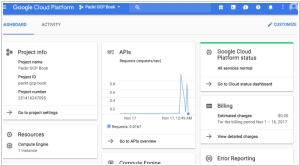DigitalOcean vs Google Cloud Platform
March 17, 2025 | Author: Michael Stromann
13★
Cloud computing platform for developers. Allows easily build, test, manage, scale applications of any size and also build, train and deploy AI apps and AI agents.
16★
Google Cloud Platform is a set of modular cloud-based services that allow you to create anything from simple websites to complex applications. Cloud Platform provides the building blocks so you can quickly develop everything from simple websites to complex applications. Explore how you can make Cloud Platform work for you.
See also:
Top 10 Public Cloud Platforms
Top 10 Public Cloud Platforms
DigitalOcean and Google Cloud Platform are, at first glance, two incredibly similar things—like two nearly identical sandwiches, except one comes with a confusing pricing structure and the other with a slightly smug air of superiority. Both offer cloud computing, virtual machines and enough scalable infrastructure to make even the most ambitious startup founder briefly consider world domination. They both love containers, which means if you enjoy shoving things into other things for portability and efficiency, you’re in luck. And, of course, they both claim to be global, which is a fancy way of saying they have computers in a lot of places, usually somewhere far away from you.
DigitalOcean was born in 2011, which, in tech years, makes it just old enough to start shaking its fist at younger platforms while still being cool. It was designed for developers who like their cloud simple, predictable and preferably not requiring a PhD to operate. It thrives on flat pricing, an intuitive dashboard and a community of users who will happily explain everything to you, whether you want them to or not. It also has Droplets, which are essentially virtual machines with a charming name, because branding is important when you're competing against giant, faceless corporations.
Google Cloud Platform, on the other hand, arrived in 2008, making it slightly older and vastly more sophisticated in a “we are the future” kind of way. It’s built for enterprises, large-scale analytics and people who enjoy running AI models in their spare time, presumably while sipping artisanal coffee. Unlike DigitalOcean’s straightforward approach, GCP offers complex, per-second billing, which ensures that no human being will ever fully understand their invoice. It also integrates seamlessly with Google’s vast, omniscient ecosystem, meaning your machine learning project can be analyzed, monetized and possibly sent to the moon before you’ve even had breakfast.
See also: Top 10 Public Cloud Platforms
DigitalOcean was born in 2011, which, in tech years, makes it just old enough to start shaking its fist at younger platforms while still being cool. It was designed for developers who like their cloud simple, predictable and preferably not requiring a PhD to operate. It thrives on flat pricing, an intuitive dashboard and a community of users who will happily explain everything to you, whether you want them to or not. It also has Droplets, which are essentially virtual machines with a charming name, because branding is important when you're competing against giant, faceless corporations.
Google Cloud Platform, on the other hand, arrived in 2008, making it slightly older and vastly more sophisticated in a “we are the future” kind of way. It’s built for enterprises, large-scale analytics and people who enjoy running AI models in their spare time, presumably while sipping artisanal coffee. Unlike DigitalOcean’s straightforward approach, GCP offers complex, per-second billing, which ensures that no human being will ever fully understand their invoice. It also integrates seamlessly with Google’s vast, omniscient ecosystem, meaning your machine learning project can be analyzed, monetized and possibly sent to the moon before you’ve even had breakfast.
See also: Top 10 Public Cloud Platforms





